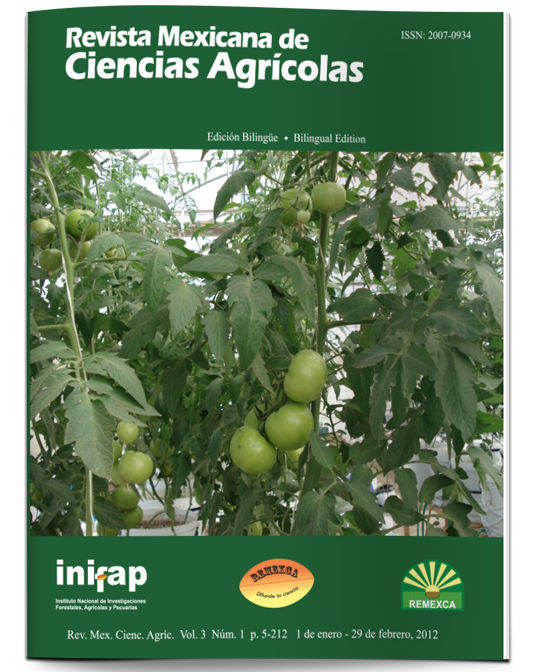Relation nitrate/ammonium/urea and potassium concentration in hydroponic tomato production
DOI:
https://doi.org/10.29312/remexca.v3i1.1485Keywords:
Solanum lycopersicum L., nutrient content, hydroponic, nutrient solutionsAbstract
Tomato plants (Solanum lycopersicum L. cv. IB-9) were grown in a hydroponic system in order to evaluate the effect of the ratio nitrate, ammonium, urea (100/0/0, 85/15/0, 85 / 0/15 and 85/7.5/7.5) and the concentration of potassium (7 and 9 mol m-3) in fruit yield and mineral composition of plants. The fruit yield was unaffected by the treatments, so that it can substitute 15% of the total nitrate nitrogen to the nutrient solution with an equal percentage of nitrogen or urea, or a mixture of ammonia and urea, each at 7.5 %. The phosphorus content in leaves was significantly increased by the interaction of 85/15/0 and 9 mol of potassium m-3, while the calcium concentration in leaves 100/0/0 statistically decreased and 9 mol m-3 potassium.
Downloads
Downloads
Published
How to Cite
Issue
Section
License
The authors who publish in Revista Mexicana de Ciencias Agrícolas accept the following conditions:
In accordance with copyright laws, Revista Mexicana de Ciencias Agrícolas recognizes and respects the authors’ moral right and ownership of property rights which will be transferred to the journal for dissemination in open access. Invariably, all the authors have to sign a letter of transfer of property rights and of originality of the article to Instituto Nacional de Investigaciones Forestales, Agrícolas y Pecuarias (INIFAP) [National Institute of Forestry, Agricultural and Livestock Research]. The author(s) must pay a fee for the reception of articles before proceeding to editorial review.
All the texts published by Revista Mexicana de Ciencias Agrícolas —with no exception— are distributed under a Creative Commons License Attribution-NonCommercial 4.0 International (CC BY-NC 4.0), which allows third parties to use the publication as long as the work’s authorship and its first publication in this journal are mentioned.
The author(s) can enter into independent and additional contractual agreements for the nonexclusive distribution of the version of the article published in Revista Mexicana de Ciencias Agrícolas (for example include it into an institutional repository or publish it in a book) as long as it is clearly and explicitly indicated that the work was published for the first time in Revista Mexicana de Ciencias Agrícolas.
For all the above, the authors shall send the Letter-transfer of Property Rights for the first publication duly filled in and signed by the author(s). This form must be sent as a PDF file to: revista_atm@yahoo.com.mx; cienciasagricola@inifap.gob.mx; remexca2017@gmail.
This work is licensed under a Creative Commons Attribution-Noncommercial 4.0 International license.



